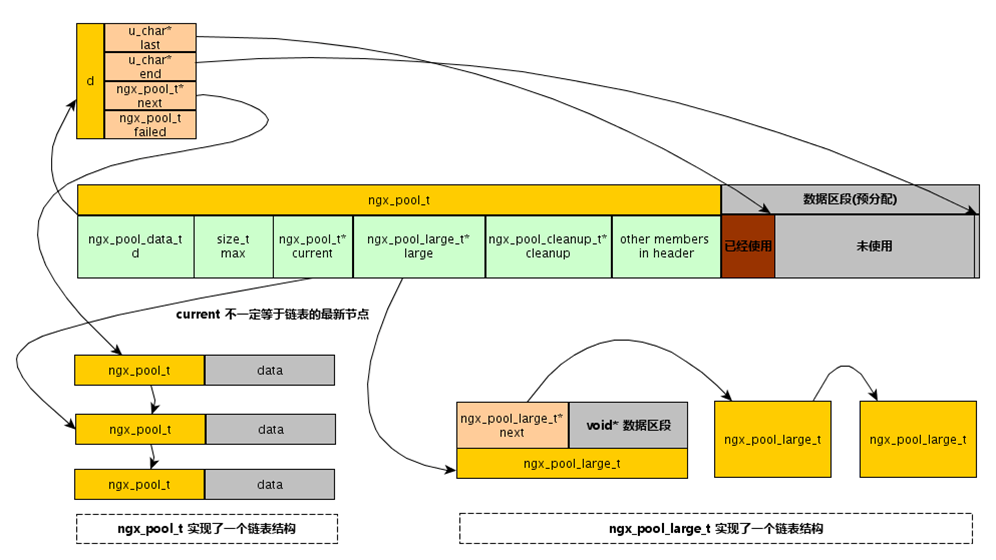内存分配相关
1. 系统功能封装
内存相关的操作主要在os/unix/ngx_alloc.{h,c} 和 core/ngx_palloc.{h,c}中。
其中os/unix/ngx_alloc.{h,c}封装了最基本的内存分配函数,是对c原有的malloc/free/memalign等函数的封装,对应函数为:
a.ngx_alloc:对malloc进行了简单的封装;
- void *
- ngx_alloc(size_t size, ngx_log_t *log)
- {
- void *p;
- p = malloc(size);
- if (p == NULL) {
- ngx_log_error(NGX_LOG_EMERG, log, ngx_errno,
- "malloc(%uz) failed", size); }
- ngx_log_debug2(NGX_LOG_DEBUG_ALLOC, log, 0, "malloc: %p:%uz", p, size);
- return p;
- }
b.ngx_calloc:使用ngx_alloc分配内存,并且把内存赋值0:
- void *
- ngx_calloc(size_t size, ngx_log_t *log)
- {
- void *p;
- p = ngx_alloc(size, log);
- if (p) {
- ngx_memzero(p, size); }在core/ngx_string.h中定义
- // #define ngx_memzero(buf, n) (void) memset(buf, 0, n) 初始化为0
- return p;
- }
c. ngx_memalign 返回基于一个指定的alignment大小的数值为对齐基数的空间
d.ngx_free 内存释放操作
2. nginx内存池
为了方便系统模块对内存的使用,方便内存的管理,nginx自己是信了进程池机制来进行内存的分配和释放,首先nginx会在特定的生命周期帮你统一建立内存池,当需要进行内存分配的时候同一通过内存池中的内存进行分配,最后nginx会在适当的时候释放内存吃的资源,开发者只要在需要的时候对内存进行申请即可,不用过多考虑释放的问题,这也就是在os/unix/ngx_alloc.c文件中没有看到free操作的原因吧。
下面来看一下内存池的主要结构:
- <span style="font-size:16px;">ngx_palloc.h
- struct ngx_pool_s {
- ngx_pool_data_t d;
- size_t max;
- ngx_pool_t *current;
- ngx_chain_t *chain;
- ngx_pool_large_t *large;
- ngx_pool_cleanup_t *cleanup;
- ngx_log_t *log;
- };
- typedef struct {
- u_char *last;
- u_char *end;
- ngx_pool_t *next;
- ngx_uint_t failed;
- } ngx_pool_data_t;
- ngx_core.h
- typedef struct ngx_pool_s ngx_pool_t;
- typedef struct ngx_chain_s ngx_chain_t;
- </span>

下面是几个比较重要的操作
- <span style="font-size:16px;">src/core/ngx_palloc.c
- //创建内存池
- ngx_pool_t *
- ngx_create_pool(size_t size, ngx_log_t *log)
- {
- ngx_pool_t *p;
- p = ngx_memalign(NGX_POOL_ALIGNMENT, size, log); //创建对其空间
- if (p == NULL) {
- return NULL;
- }
- p->d.last = (u_char *) p + sizeof(ngx_pool_t); //初始指向ngx_pool_t结构体后面
- p->d.end = (u_char *) p + size; //整个结构体的结尾
- p->d.next = NULL; //没有next
- p->d.failed = 0;
- size = size - sizeof(ngx_pool_t); //剩余大小
- p->max = (size < NGX_MAX_ALLOC_FROM_POOL) ? size : NGX_MAX_ALLOC_FROM_POOL;//最大不超过NGX_MAX_ALLOC_FROM_POOL
- //#define NGX_MAX_ALLOC_FROM_POOL (ngx_pagesize - 1)
- p->current = p;
- p->chain = NULL;
- p->large = NULL;
- p->cleanup = NULL;
- p->log = log;
- return p;
- }
- //销毁内存池
- void
- ngx_destroy_pool(ngx_pool_t *pool)
- {
- ngx_pool_t *p, *n;
- ngx_pool_large_t *l;
- ngx_pool_cleanup_t *c;
- for (c = pool->cleanup; c; c = c->next) {//如果注册了clenup(一种链表结构),会依次调用clenup的handler进行清理
- if (c->handler) {
- ngx_log_debug1(NGX_LOG_DEBUG_ALLOC, pool->log, 0,
- "run cleanup: %p", c);
- c->handler(c->data);
- }
- }
- for (l = pool->large; l; l = l->next) { //遍历链表,释放所有large内存
- ngx_log_debug1(NGX_LOG_DEBUG_ALLOC, pool->log, 0, "free: %p", l->alloc);
- if (l->alloc) {
- ngx_free(l->alloc);
- }
- }
- #if (NGX_DEBUG) //等译debug级别,如果为true,会打印日志
- /*
- * we could allocate the pool->log from this pool
- * so we cannot use this log while free()ing the pool
- */
- for (p = pool, n = pool->d.next; /* void */; p = n, n = n->d.next) {
- ngx_log_debug2(NGX_LOG_DEBUG_ALLOC, pool->log, 0,
- "free: %p, unused: %uz", p, p->d.end - p->d.last);
- if (n == NULL) {
- break;
- }
- }
- #endif
- for (p = pool, n = pool->d.next; /* void */; p = n, n = n->d.next) {//遍历链表 ,释放内存空间
- ngx_free(p);
- if (n == NULL) {
- break;
- }
- }
- }
- //重置内存池
- void
- ngx_reset_pool(ngx_pool_t *pool)
- {
- ngx_pool_t *p;
- ngx_pool_large_t *l;
- for (l = pool->large; l; l = l->next) { //释放掉所有large段内存
- if (l->alloc) {
- ngx_free(l->alloc);
- }
- }
- pool->large = NULL;
- for (p = pool; p; p = p->d.next) {
- p->d.last = (u_char *) p + sizeof(ngx_pool_t);将指针重新指向ngx_pool_t(和创建时一样)
- }
- }
- //从内存池里分配内存
- void * ngx_palloc(ngx_pool_t *pool, size_t size)
- void * ngx_pnalloc(ngx_pool_t *pool, size_t size)
- void * ngx_pmemalign(ngx_pool_t *pool, size_t size, size_t alignment)
- void * ngx_pcalloc(ngx_pool_t *pool, size_t size)
- 这里以ngx_palloc为例讲解,其他大同小异:
- void *
- ngx_palloc(ngx_pool_t *pool, size_t size)
- {
- u_char *m;
- ngx_pool_t *p;
- if (size <= pool->max) { //判断分配内存是否大于pool->max,如果小于等于
- p = pool->current; //尝试从链表的current开始遍历,
- do {
- m = ngx_align_ptr(p->d.last, NGX_ALIGNMENT);
- //#define ngx_align_ptr(p,a)
- //(u_char *) (((uintptr_t) (p) + ((uintptr_t) a - 1)) & ~((uintptr_t) a - 1))
- if ((size_t) (p->d.end - m) >= size) { //当找到可以分配的空间时
- p->d.last = m + size;
- return m; //分配内存后返回
- }
- p = p->d.next;
- } while (p);
- return ngx_palloc_block(pool, size);//如果无法分配内存,就生成一个新的节点,同时pool->current指针指向新的位置
- }
- return ngx_palloc_large(pool, size); //如果分配的内存大于pool->max则在large链表分配一段内存
- }
- //释放指定的内存
- ngx_int_t
- ngx_pfree(ngx_pool_t *pool, void *p){
- ngx_pool_large_t *l;
- for (l = pool->large; l; l = l->next) {
- if (p == l->alloc) { //存在alloc注册
- ngx_log_debug1(NGX_LOG_DEBUG_ALLOC, pool->log, 0,
- "free: %p", l->alloc);
- ngx_free(l->alloc);
- l->alloc = NULL;
- return NGX_OK;
- }
- }
- return NGX_DECLINED;
- }//由代码可以看出,这个操作只有在内存large链表里面注册内存才会真正释放,如果分配的是普通的内存,则会在destory_pool的时候统一释放。
- //注册cleanup回调函数
- ngx_pool_cleanup_t *
- ngx_pool_cleanup_add(ngx_pool_t *p, size_t size)
- {
- ngx_pool_cleanup_t *c;
- c = ngx_palloc(p, sizeof(ngx_pool_cleanup_t)); //分配cleanup空间
- if (c == NULL) {
- return NULL;
- }
- if (size) {
- c->data = ngx_palloc(p, size); //为cleanup结构体分配data空间
- if (c->data == NULL) {
- return NULL;
- }
- } else {
- c->data = NULL;
- }
- c->handler = NULL;
- c->next = p->cleanup;
- p->cleanup = c; // 增加cleanup
- ngx_log_debug1(NGX_LOG_DEBUG_ALLOC, p->log, 0, "add cleanup: %p", c);
- return c; //返回结构体分配的空间
- }</span>






















 581
581

 被折叠的 条评论
为什么被折叠?
被折叠的 条评论
为什么被折叠?








